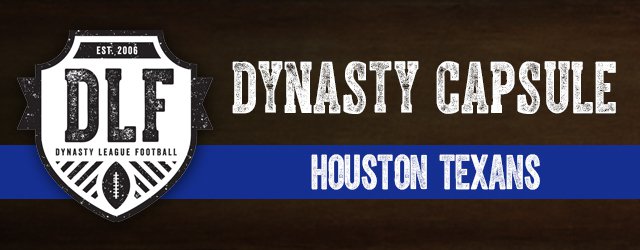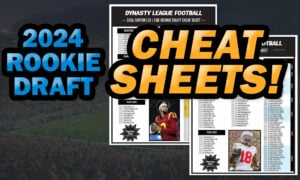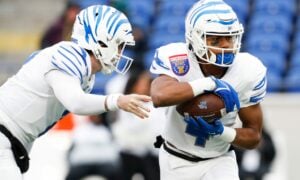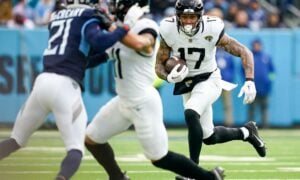Dynasty Capsule: Houston Texans

Every year we give our premium content members a team-by-team, player-by-player look at the NFL season that was. The coverage will be in-depth, but because the Dynasty Capsule series begins immediately after the regular season, we won’t use it to discuss free agency or the draft. Come see us in early May once Mr. Irrelevant is off the board for another 32-article series giving you the same detailed discussion you’ll see below.
Buckle up dynasty fans, because you’re about to be reminded why our motto is, “There is no off-season.”
The focus continues to be on the Texans defense, but the offense has shown itself to have some value. The team led the league in total plays (1,127), placing in the top ten for both rushing attempts (3rd) and passing attempts (9th). Quantity though, does not equal quality, as they were one of two teams to average less than five yards per play. Let’s just dive right into this mixed bag!
[am4show have=’g1;’ guest_error=’sub_message’ user_error=’sub_message’ ]
Quarterbacks
Hoyer was the best of the Houston quarterbacks, which is like being the tallest kindergartner. He broke the 60 percent completion threshold for the first time in his career (60.7) and shaved over a full percentage point off his interception rate from 2014 (3.0 to 1.9). Outside of the unfortunate playoff game against Kansas City, Hoyer never threw more than one interception in a game all season. Sadly, injuries took hold of his season, suffering two concussions in under a month along with other assorted bumps and bruises.
Heading into 2016, Hoyer has a $4 million base salary which should keep him in the driver’s seat of this offense. His biggest threat is the potential addition of a quarterback via the draft. Hoyer remains a fringe draft option in DLF mocks, meaning you can get him after pick 240, a nice value for a player who could flirt with QB1 numbers if healthy.
Yates and Weeden were both granted some spot spots as Hoyer went down with injury and Ryan Mallett proved to be less than adequate. Each had moments of success and won all three games they started if quarterback wins are important to you. Now, both are free agents and at best, only one gets re-signed. Yates has the history with the team but Weeden showed more during his stops in Dallas and Houston in 2015.
Remember him? The former fourth rounder was redshirted last year after a severe injury to the shoulder of his throwing arm during the preseason. Savage watched as four different quarterbacks started, likely jealous of not having a chance to get in on the action. A live arm with little accuracy, Savage still needs polish to become anything more than a backup.
Running Backs
Assuming he decides to play another season, the team is going to likely release the runner as his salary is non-guaranteed ($8.9 million). Foster’s 2015 was rough, he missed the first three weeks of the season, only to come back and average 2.6 yards per carry over the next four games before being injured again and out for the season. Foster did do well in the pass game, managing 22 receptions in those four weeks, catching 79 percent of his targets.
While Foster still has something left, he may be best served as a complementary runner from this point forward. My best guess is Foster finding a spot with a contending team and serves as the pass catching option. The uncertainty has him as the RB43 in the January DLF ADP data, which still may be too rich for me.
Blue led the team in carries (183), largely when Foster was injured, and was the only player with multiple rushing touchdowns with two. While the overall product was disappointing, he did have three games of 99 or more rushing yards in the last four weeks of the season. As the only running back who played significant time besides Foster signed for 2016, Blue still holds some value here. I expect the team to find a running back in free agency or the draft, but at RB65, Blue is worth a chance knowing how much the team runs the ball.
Grimes and Polk were the other running backs who filled in for Foster in 2015, particularly in the passing game where Blue is limited. They are free agents this year and while still young, both are 26, are no more than backups at this point. Mock drafters are thinking the same thing as neither are in the top 85 running backs selected as of January.
Both are signed into 2016, with Hunt on the main roster and Hilliard signed to a reserve/futures deal. The position is wide open so they are capable of solidifying backup roles, but if they draft a running back, one of them could easily be left off the team.
Wide Receivers
In case you did not hear, Hopkins was the first wide receiver to ever manage 100 yard receiving games from four different quarterbacks in one season. Hopkins was consistent too as he had five receptions and/or 50 receiving yards in every game this season, partially fueled by 13 games of 10+ targets, second in the league behind Julio Jones (14). One more: Only 13 receivers have ever managed a season of 100 catches, 1,500 yards, and 10 touchdowns (list).
Hopkins looks like he is quarterback proof, game script proof, and pretty much matchup proof. Heading into 2016, there is no receiver who will infringe on his workload, although a second option emerging could give Hopkins a few better looks. Nuk has now ascended to WR4 in the January DLF ADP and it is hard to argue the 23-year-old does not deserve to be there.
If there is something Washington will never be accused of, it is efficiency. His 50 percent catch rate was on par with his career number (52.4 percent) and after seeing eight or more targets in each of his first four full games, it only happened one more time all season. Now, as an unrestricted free agent, Washington’s future in Houston is unclear. At 32 and with younger options on the team, his WR110 ADP seems reasonable.
For the fourth-straight season, Shorts saw declines in his receiving yards (484) and had his lowest reception total (42) since his rookie year. Much of that can be attributed to missing five games and parts of several others, along with his role as the underneath option in this offense. Shorts is the best slot option and while only $500,000 of his salary is guaranteed, I suspect he remains the veteran presence of this receiving group. Shorts is the WR105, which is a fair value given the play heavy nature of the offense.
Anyone who drafted Jaelen Strong last year must have been disappointed, expecting him to have more than the 14 catches and 161 yards he accumulated. There were a few bright spots, including the two touchdown performance in his debut as well as a few other highlight reel receptions. If Washington is left unsigned, I suspect Strong will start opposite Nuk with Shorts manning the slot. Given Washington’s 94 targets last year, that role could be lucrative. He is the WR51 in the latest ADP and while I prefer a few others in that range, it is a fair price to pay.
When injuries hit the wide receivers early in the year, it was Mumphery who saw the extended time. During that two game stretch, he had 15 targets, catching eight for 79 yards. Mumphery has the look of a possession receiver, which has more value in an offense like Houston who uses their tight ends to block. He is not being drafted in the top 240 and is worth a speculative grab in deep leagues.
Tight Ends
This team is no fun for tight ends, but Griffin did lead the team in receptions (20) and targets (34) despite missing seven games last year. He only surpassed 30 yards twice, meaning he will be touchdown reliant for value. No Houston tight end is being drafted in the top 240 picks. No reason to change that.
While Fiedorowicz took over receiving duties when Griffin was hurt, he still failed to surpass three targets in a single game or 30 yards. He had the look of being a reliable receiving tight end when he was drafted, but Houston is not kind to tight ends and here is Exhibit A.
Graham is the blocking tight end. He is rarely used on passing downs and with just four receptions on 19 targets, that should not change. Avoid at all costs.
[/am4show]
- Bowl Game Previews: CFB Playoff Semifinals - December 28, 2018
- The Narrative Fallacy and How it Compels Us - May 13, 2017
- 2017 NFL Draft – College Wide Receiver AIR - April 27, 2017

































































